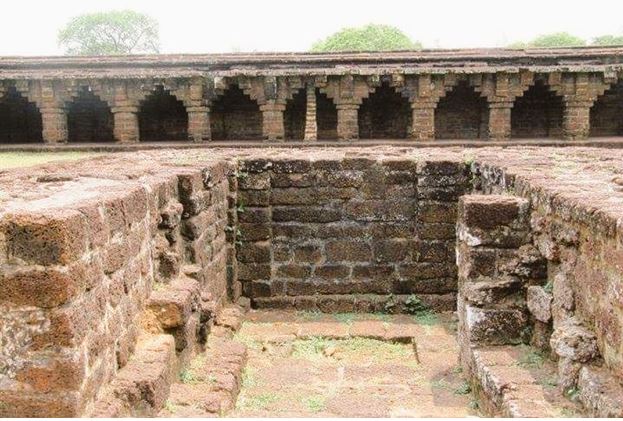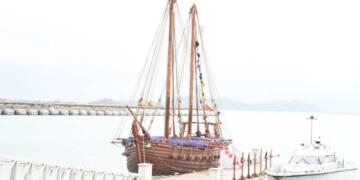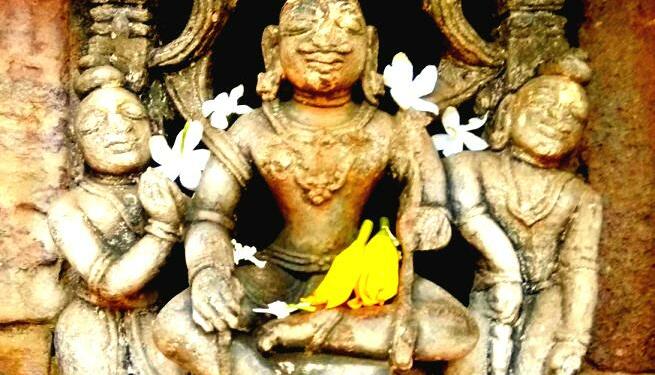The tiger took a step backward. Its eyes glazed on its prey. A growl echoed from its mouth, its tail was swinging like a viper ready to make a strike. Its prey, a 12 year old human kid seemed to stand no chance against the brute animal. The tiger finally made its leap.
The Ganga emperor Bhanudeva IV saw the mightiest act of courage in his life. The 12 year old kid single-handedly killed the tiger after a swift battle even before any help could reach him out. Bhanudeva IV decided to gather more information about the kid.
It turned out that the kid, born to father Jageswara Routa and mother Bellama, was no ordinary boy. The third son of a man from a family which claimed lineage from the Suryavamsa dynasty, the kid was already a famous legend in the town. One day while he was resting under a tree, a handful of people noticed that a Naga (king cobra) was sitting besides his head as if covering the sunlight. Whether it was true or not nobody knows, but when the words spread out like rumors, people considered it a prophecy foretelling that the boy is destined to be a mighty king one day.

[Suryavamsa lineage as explained in inscriptions of Sarasvativilasam and copper plates of Raghudeva-Narendra: Source- The Suryavamsi Gajapatis of Orissa by R. Subrahmanyam]
Childless Bhanudeva IV had become fond of the kid. After gaining military training followed by a series of turnout of events, the kid who grew up to be his faithful and loyal general. Madala Panji, the temple chronicles of Puri Jagannath Temple kept record of this historical event which was about to change the history of Kalinga.
Over the years, the kingdom of Kalinga was engaged in various feuds with its hostile neighbors like the Reddys of Rajamundry in South, the Sultan of Bengal in North, the distant Malwas etc. With the falling health of Bhanudeva IV, the royal administration was slowly degrading day by day.
The last emperor of the Gangas, king Bhanudeva IV met his downfall during a protracted struggle against the Reddys of Rajahmundry in distant south by that time. As the news spread, various chieftains and vassal kings of Kalinga declared themselves independent since Bhanudeva IV left no legal heir. Hostile neighbors tried to capitalize during this time of confusion and declared collective war against Kalinga.
The prophecies became true. Astonishing everyone who posed a potential threat to Kalinga, the loyal general of Bhanudeva IV ascended to the throne himself and took the reigns under his strong and worthy hands. On the day of 2 kākara śukḷa 4 aṅka 2 which coincides with June 29th of Gregorian calendar, the hasty coronation of Kapilendra Deva Routray took place under the priests and his loyal subjects at Kritivasa Kataka- the modern day Bhubaneswar.

Military campaigns of Kapilendra Deva Routray:

- In the South, the Reddy rulers of Rajahmumdry were extending their frontiers further north.
- From the North, the kingdom was threatened by the Sultan of Bengal.
- The distant Malwa also tried to take advantage of the revolution of local chiefs and feudatories who refused to acknowledge the suzerainty of Kapilendra Deva.
At that critical juncture, Kapilendra Deva Routray took immediate steps and subdued the rebel chiefs like the Matsyas of Oddadi, the Salivamsi chiefs of Nandapura, the Vishnuvardhana Chakravartins of Panchadharala and the Gangas of Khimindi. His Lingaraj temple inscription thus reveals: “all kings of my kingdom of Odisha should work for the good of the paramount sovereign and should keep to virtuous ways and not remain in bad ways. If they act badly towards their sovereign, they will be expelled from the kingdom and all their property would be confiscated.” This order definitely directed the defiant chiefs to acknowledge the suzerainty of Kapilendra Deva.
Regarding the hostile neighbors, Kapilendra Deva made a remarkable feat in sending a strong message to them:-
- Victory over Gauda:- After his accession, Kapilendra Deva wanted to settle the score with the lllyas Shahis of Bengal. Taking the internal quarrel of the Sarquis of Jaunpur, the Gangas had extended the frontier of Odisha upto the river Bhagirathi (Ganges). While fighting against the combined army of the Reddys of Rajahmundry and Vijayanagar Empire, Kapilendra Deva received the news of the attack of sultan Nasiruddin Abul Muzzafar Mahmud Shah of Bengal. He rushed immediately and inflicted a crushing defeat upon him extending the sway of Gajapati Empire up to the river Ganges. In an inscription dated 1447 A.D., Kapilendra Deva assumed the title ‘Gaudeswara’. An inscription in the Jagannatha temple of Puri that is dated to the year 1450 A.D narrates the conquest of Gauda by Kapilendra Deva after defeating Malika Parisa (Malik Padsah) which in short refers to the contemporary sultan of Bengal by the name Nasiruddin Abul Muzzafar Mahmud Shah. After this victory, Kapilendra Deva Routray accepts the title epithet of ‘Gaudeswara’ which meant the Lord of Gauda kingdom. It is affirmed that Kapilendra Deva had won victory over Bengal. His minister Gopinath Mahapatra was key factor in defeating Jaunpur forces. According to some rare but debatable sources, Kapilendra Deva had another minister named Joginath Mahapatra who played pivotal role in defeating Bengal sultanate and capturing Gauda. During his Bengal campaign, Kapilendra Deva had built the Kurumabedha Fort in Gangeswar village, West Bengal (1438-69).




- Capture of Rajahmundry/Rajamahendri: Defeated Virbhadra I of Reddys and captured the province Rajahmundry.
- First Campaign in 1444 A.D. – The Rajamundry Reddys were ally of Vijayanagar kingdom. When Kapilendra Deva Routray decided to carry out a campaign against the alliance of Vijayanagar kingdom and Rajamahendri Reddys, he received the news of attacks from Jaunpur Muslim forces in the north. The Vijayanagar forces were also a formidable foe under the leadership of Devaraya II’s commender-in-chief Mallapa. Kapilendra Deva first decided to deal with the invasions in the northern frontiers before attacking Vijayanagar. Hence, his campaign in the south was suspended for the time being.
- Second Campaign in 1446 A.D. and Capture of Kondavidu by Hamvira Deva: The territory to the south of river Krishna was under the authority of the Vijayanagar Empire. Two years later in 1446 A.D, the Gajapati army led by Hamvira Deva or Hamvira Kumara Mahapatra, the eldest son of Kapilendra Deva Routray returned to complete the unfinished task. By this time, the political alliance between Vijayanagar and the Reddy kingdom had ceased to exist as Devaraya II had died and the power passed on to a weaker successor, Malikarjuna Raya who had made the Reddys upset at some point of time. Kapilendra Deva’s army defeated and conquered the Reddy kingdom and the Odia forces occupied Kondavidu by the year 1454 A.D. Kapilendra Deva appointed Ganadeva Routray one of his relatives as the Pariksha or vassal king/feudal ruler of Kondavidu. Hamvira Deva was declared as the governor of the southern territories by Kapilendra Deva after this conquest.
- Victory of Telangana: Initially, the Velama Chiefs and Bahamani Sultan Alladin Ahmad Shah II had cordial relationships. The Velama Chiefs had sided with all parties at some time or the other right from the Bahmani Sultanate to Vijayanagar Empire and the local lords as well. However, when Bahamani Sultanate asked Velamas to assist them during their attack on Vijayanagar, the Velamas backed out from the campaign. This enraged the Bahamani Sultanate. The Velamas were constantly attacked by the Bahamanis since then. The Bahmani commander Sanjar Khan exerted barbaric atrocities on the common people. Hindu men and children were either killed or sold as slaves while Hindu women were raped. In 1456 A.D. Humayun Shah ascended to the throne of the Bahmani sultanate and his general Sikander Khan suppressed the rebel Velama Chiefs after occupying Devarakonda. The Velamas had no choice but to sought help from Kapilenda Deva.

The battle wasn’t over though. The Kalinga army marched towards Warangal. The Velamas went towards Rajachal. Kumara Hamvira led his troops to attack the Warangal fort which was under the command of polymath Mahmud Gawan, who would later become the prime minister of Mahmud Shah III Bahamani. The Warangal fort soon fell to the Gajapati army.



- Capture of Bahamani Kingdom:
- First Campaign: After the death of Humayun Shah in 1462 A.D., his underage son Nizam Shah was crowned as the ruler of the Bahmani sultanate. After gaining allies like Velama Chiefs, Kapilendra Deva’s army invaded Bahamani kingdom and marched towards Bidar, the capital of Bahamani kingdom. This victory reaffirmed the title of Kalabargeswara which Kapilendra Deva took after the victory of Devarkonda. However, Kapilendra Deva Routray soon received the news of Muslim Sharqui ruler of Jaunpur attacking the North Frontier of Kalinga with 3,00,000 cavalry and 1400 war elephants. He had to leave the conquest of Bidar to deal with Jaunpur forces.
- Second Campaign: Defeating the Jaunpur forces quickly, Kapilendra Deva Routray resumed his campaign against Bahamani sultanate. Bahamanis were already dealing with attacks from Malwa kingdom. Kapilendra Deva’s army first captured Hahur and then the capital of Bidar. According to some rare and debatable sources, few days after capturing Bidar the Odia army defeated the Malwa forces and captured Dhara, capital of Malwa.
- Battle with Vijayanagar: Saluva Narasimha, the subordinate ruler of Chandragiri under the Vijayanagar Empire was dreaming of building his own castle over the Vijayanagar Empire. Kapilendra Deva wanted to conquer Udayagiri. The old fort occupied a strategic position of the Vijayanagara Empire in the coastal regions. By the instruction of Kapilendra Deva, his lieutenant Tamma Bhupala conquered Udayagiri. As per an inscription found at the top of Udayagiri hill, the construction of a temple was done too to mark the victory. After the conquest of Udayagiri, Basava Bhupala, son of Tamma Bhupala was appointed as its governor. After capturing Udaygiri, Kapilendra Deva rebuilt the Udayagiri fort as the military headquarters of southern territory of Kalinga Empire. With Udayagiri as base, Hamvira, the valiant son of Kapilendra Deva, marched along the coastal line of the Vijayanagar Empire.


Cultural renaissance under Kapilendra Deva.
Kapilendra Deva’s entire life was spent in repeated warfare and dealings with rebellious chiefs. In inscriptions, he was mentioned as the “Navakoti Karnata Kalabargeswara Gajapati Goudeswara Sri Sri Kapileswara Deva” which literally means “Lord of Nine forts (viz Kondavidu, Chandragiri, Arcot.) & Karnata Kalabargi (Gulbarga region) Goudeswara (Lord of Bengal)”. In a refined manner, it translates to “Lord of nine crore subjects and lord of Bengal (Gauda), of Karnataka region/Vijayanagara kingdom, of Golkonda kingdom”.
Kapilendra Deva was a patron of Vaishnava. He expanded the Jagannatha Temple in Puri. Soon under his patronage, the Puri Jagannatha temple became the center of efflorescence of drama, dance forms (Odissi) and other forms of art. Kapilendra Deva was a great patron of Vedic culture and had written a Sanskrit play called Parashuram Bijaya. Odia language has an uninterrupted history of evolution (ancient Odia, medieval Odia and modern day Odia) of 2000 years and the modern day Odia became the official language of administration during his reigns. Under his patronage, Odia poet Sarala Das wrote the Odia Mahabharata known as Sarala Mahabharata. Various other poets and writers were also promoted by him, notable among them were:-
- Visvanatha Kaviraja, who wrote Sahitya Darpana and Chandrakala Natika along with other works.
- Narsingha Mishra Vajapeyi, who wrote Samksepasariraka vartika.
- Kalidasa Chayani, who wrote Suddhichandrika.
Religious activities of Kapilendra Deva:
Though he was a staunch Vaishnava, Kapilendra Deva built the famous Shiva temple named Kapileswara temple in Bhubaneswara. Kapilendra Deva took the title of Routray which literally translates to “chief servant among all servants”. Routa or Rauta means “sevaka” or servant, while Raya means king. So literally, Kapilendra Deva declared himself as the chief sevaka, or king of sevakas of Lord Jagannatha.



Kapilendra Deva Routray, whose coronation took place on 29th June, went on to establish one of the mightiest empire and dynasty in the history of Kalinga- the mighty Routray Gajapati dynasty. However during the last days of his life, Kapilendra Deva faced a disturbed mindset due to treacherous internal subjects. Owing to his troubled state of mind, he chose his younger son Purushottam Deva as the successor to the throne rather than the much worthy Hamvira Mohapatra. This led to the war between two brothers, which proved advantageous to Bengal Sultanate, Bahamanis and Vijayanagar. Due to unstable administration, Kalinga lost a lot of border territories. Hamvira Mohapatra defeated Purushottam Deva and ascended to the throne briefly. However, soon Purushottam Deva made a massive attack and regained the throne for himself in a decisive victory. Hamvira promised to not fight for the throne again. Purushottam Deva again had to start everything afresh with an eye to gain back the lost territories of Kalinga.


































I wish the intelligent and capable kinds had shown the wisdom of distinguishing between their own kind of kingdoms and those of the outsiders. Had the Indian kings united against the Nizams, Sultanates, Moghuls, we would have preserved our culture and way of life in much better way.